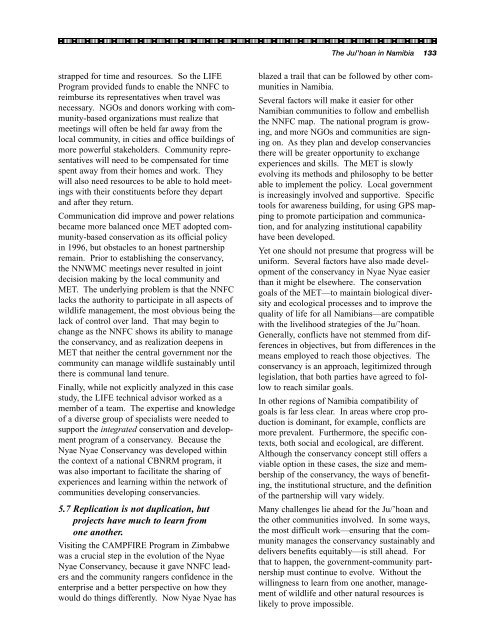Indigenous Peoples and Conservation Organizations
Indigenous Peoples and Conservation Organizations
Indigenous Peoples and Conservation Organizations
Create successful ePaper yourself
Turn your PDF publications into a flip-book with our unique Google optimized e-Paper software.
The Ju/’hoan in Namibia 133<br />
strapped for time <strong>and</strong> resources. So the LIFE<br />
Program provided funds to enable the NNFC to<br />
reimburse its representatives when travel was<br />
necessary. NGOs <strong>and</strong> donors working with community-based<br />
organizations must realize that<br />
meetings will often be held far away from the<br />
local community, in cities <strong>and</strong> office buildings of<br />
more powerful stakeholders. Community representatives<br />
will need to be compensated for time<br />
spent away from their homes <strong>and</strong> work. They<br />
will also need resources to be able to hold meetings<br />
with their constituents before they depart<br />
<strong>and</strong> after they return.<br />
Communication did improve <strong>and</strong> power relations<br />
became more balanced once MET adopted community-based<br />
conservation as its official policy<br />
in 1996, but obstacles to an honest partnership<br />
remain. Prior to establishing the conservancy,<br />
the NNWMC meetings never resulted in joint<br />
decision making by the local community <strong>and</strong><br />
MET. The underlying problem is that the NNFC<br />
lacks the authority to participate in all aspects of<br />
wildlife management, the most obvious being the<br />
lack of control over l<strong>and</strong>. That may begin to<br />
change as the NNFC shows its ability to manage<br />
the conservancy, <strong>and</strong> as realization deepens in<br />
MET that neither the central government nor the<br />
community can manage wildlife sustainably until<br />
there is communal l<strong>and</strong> tenure.<br />
Finally, while not explicitly analyzed in this case<br />
study, the LIFE technical advisor worked as a<br />
member of a team. The expertise <strong>and</strong> knowledge<br />
of a diverse group of specialists were needed to<br />
support the integrated conservation <strong>and</strong> development<br />
program of a conservancy. Because the<br />
Nyae Nyae Conservancy was developed within<br />
the context of a national CBNRM program, it<br />
was also important to facilitate the sharing of<br />
experiences <strong>and</strong> learning within the network of<br />
communities developing conservancies.<br />
5.7 Replication is not duplication, but<br />
projects have much to learn from<br />
one another.<br />
Visiting the CAMPFIRE Program in Zimbabwe<br />
was a crucial step in the evolution of the Nyae<br />
Nyae Conservancy, because it gave NNFC leaders<br />
<strong>and</strong> the community rangers confidence in the<br />
enterprise <strong>and</strong> a better perspective on how they<br />
would do things differently. Now Nyae Nyae has<br />
blazed a trail that can be followed by other communities<br />
in Namibia.<br />
Several factors will make it easier for other<br />
Namibian communities to follow <strong>and</strong> embellish<br />
the NNFC map. The national program is growing,<br />
<strong>and</strong> more NGOs <strong>and</strong> communities are signing<br />
on. As they plan <strong>and</strong> develop conservancies<br />
there will be greater opportunity to exchange<br />
experiences <strong>and</strong> skills. The MET is slowly<br />
evolving its methods <strong>and</strong> philosophy to be better<br />
able to implement the policy. Local government<br />
is increasingly involved <strong>and</strong> supportive. Specific<br />
tools for awareness building, for using GPS mapping<br />
to promote participation <strong>and</strong> communication,<br />
<strong>and</strong> for analyzing institutional capability<br />
have been developed.<br />
Yet one should not presume that progress will be<br />
uniform. Several factors have also made development<br />
of the conservancy in Nyae Nyae easier<br />
than it might be elsewhere. The conservation<br />
goals of the MET—to maintain biological diversity<br />
<strong>and</strong> ecological processes <strong>and</strong> to improve the<br />
quality of life for all Namibians—are compatible<br />
with the livelihood strategies of the Ju/’hoan.<br />
Generally, conflicts have not stemmed from differences<br />
in objectives, but from differences in the<br />
means employed to reach those objectives. The<br />
conservancy is an approach, legitimized through<br />
legislation, that both parties have agreed to follow<br />
to reach similar goals.<br />
In other regions of Namibia compatibility of<br />
goals is far less clear. In areas where crop production<br />
is dominant, for example, conflicts are<br />
more prevalent. Furthermore, the specific contexts,<br />
both social <strong>and</strong> ecological, are different.<br />
Although the conservancy concept still offers a<br />
viable option in these cases, the size <strong>and</strong> membership<br />
of the conservancy, the ways of benefiting,<br />
the institutional structure, <strong>and</strong> the definition<br />
of the partnership will vary widely.<br />
Many challenges lie ahead for the Ju/’hoan <strong>and</strong><br />
the other communities involved. In some ways,<br />
the most difficult work—ensuring that the community<br />
manages the conservancy sustainably <strong>and</strong><br />
delivers benefits equitably—is still ahead. For<br />
that to happen, the government-community partnership<br />
must continue to evolve. Without the<br />
willingness to learn from one another, management<br />
of wildlife <strong>and</strong> other natural resources is<br />
likely to prove impossible.

















